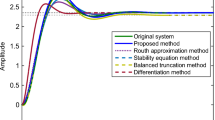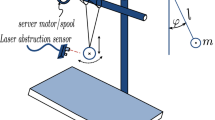Abstract
In this work, a reduced-order forward dynamics of multiclosed-loop systems is proposed by exploiting the associated inherent kinematic constraints at acceleration level. First, a closed-loop system is divided into an equivalent open architecture consisting of several serial and tree-type subsystems by introducing cuts at appropriate joints. The resulting cut joints are replaced by appropriate constraint forces also referred to as Lagrange multipliers. Next, for each subsystem, the governing equations of motion are derived in terms of the Lagrange multipliers, which are based on the Newton–Euler formulation coupled with the concept of Decoupled Natural Orthogonal Complement (DeNOC) matrices, introduced elsewhere. In the proposed forward dynamics formulation, Lagrange multipliers are calculated sequentially at the subsystem level, and later treated as external forces to the resulting serial or tree-type systems of the original closed-loop system, for the recursive computation of joint accelerations. Note that such subsystem-level treatment allows one to use already existing algorithms for serial and tree-type systems. Hence, one can perform the dynamic analyses relatively quickly without rewriting the complete model of the closed-loop system at hand. The proposed methodology is in contrast to the conventional approaches, where the Lagrange multipliers are calculated together at the system level or simultaneously along with the joint accelerations, both of which incur higher order computational complexities, and thereby a greater number of arithmetic operations. Due to the smaller size of matrices involved in evaluating Lagrange multipliers in the proposed methodology, and the recursive computation of the joint accelerations, the overall numerical performances like computational efficiency, etc., are likely to improve. The proposed reduced-order forward dynamics formulation is illustrated with two multiclosed-loop systems, namely, a 7-bar carpet scrapping mechanism and a 3-RRR parallel manipulator.








Similar content being viewed by others
References
Roberson, R.E., Schwertassek, R.: Dynamics of Multibody Systems. Springer, Berlin, Heidelberg (1988)
Shabana, A.: Forms of the dynamic equations and constrained dynamics. In: Shabana, A. (ed.) Computational Dynamics, pp. 178–209, 284–349. Wiley, Chichester (2010)
Wittenburg, J.: Systems with closed kinematic chains: general multibody systems. In: Wittenburg, J. (ed.) Dynamics of Multibody Systems, pp. 129–150. Springer, New York (2008)
Featherstone, R.: Closed loop systems. In: Featherstone, R. (ed.) Rigid Body Dynamics Algorithms, pp. 141–161. Springer, New York (2008)
Walker, M.W., Orin, D.E.: Efficient dynamic computer simulation of robotic mechanisms. J. Dyn. Syst. Meas. Control 104, 205–211 (1982)
Hollerbach, J.M.: A recursive Lagrangian formulation of manipulator dynamics and a comparative study of dynamics formulation complexity. IEEE Trans. Syst. Man Cybern. SMC-10(11), 730–736 (1980)
Blajer, W.: Dependent variable formulations. In: Ambrósio, J.A.C., Eberhard, P., Maier, G., Rammerstorfer, F.G., Salençon, J. (eds.) Advanced Design of Mechanical Systems: From Analysis to Optimization. CISM Courses and Lectures, pp. 83–105. Springer, Vienna (2009)
Blajer, W.: Elimination of constraint violation and accuracy aspects in numerical simulation of multibody systems. Multibody Syst. Dyn. 7(3), 265–284 (2002)
Baumgarte, J.: Stabilization of constraint and integrals of motion in dynamical systems. Comput. Methods Appl. Mech. Eng. 1, 1–16 (1972)
Braun, D.J., Goldfarb, M.: Eliminating constraint drift in the numerical simulation of constrained dynamical systems. Comput. Methods Appl. Mech. Eng. 198, 3151–3160 (2009)
Blajer, W.: Methods for constraint violation suppression in the numerical simulation of constrained multibody systems—a comparative study. Comput. Methods Appl. Mech. Eng. 200, 1568–1576 (2011)
Blajer, W.: Independent variable formulations. In: Ambrósio, J.A.C., Eberhard, P., Maier, G., Rammerstorfer, F.G., Salençon, J. (eds.) Advanced Design of Mechanical Systems: From Analysis to Optimization. CISM Courses and Lectures, pp. 107–129. Springer, Vienna (2009)
Kane, T.R., Levinson, D.A.: Dynamics: Theory and Applications. McGraw-Hill, New York (1986)
Angeles, J., Ma, O.: Dynamic simulation of n-axis serial robotic manipulators using a natural orthogonal complement. Int. J. Robot. Res. 7(5), 32–47 (1988)
Brauchli, H., Weber, R.: Dynamical equations in natural coordinates. Comput. Methods Appl. Mech. Eng. 91, 1403–1414 (1991)
Saha, S.K.: Dynamics of serial multibody systems using the decoupled natural orthogonal complement matrices. J. Appl. Mech. 66, 986–996 (1999)
Featherstone, R.: Robot Dynamics Algorithms. Kluwer Academic, Boston (1987)
Saha, S.K., Schiehlen, W.O.: Recursive kinematics and dynamics for parallel structured closed-loop multibody systems. Mech. Struct. Mach. 29(2), 143–175 (2001)
Wehage, R.A., Haug, E.J.: Generalized coordinate partitioning for dimension reduction in analysis of constrained dynamic systems. J. Mech. Des. 104, 247–255 (1982)
Anderson, K.S., Critchley, J.H.: Improved order-n performance algorithm for the simulation of constrained multirigid-body systems. Multibody Syst. Dyn. 9, 185–212 (2003)
Blajer, W., Schiehlen, W., Schirm, W.: A projective criterion to the coordinate partitioning method for multibody dynamics. Arch. Appl. Mech. 64, 215–222 (1994)
Avello, A., Jimenez, J.M., Bayo, E., Jalon, J.G.: A simple and highly parallelizable method for realtime dynamic simulation based on velocity transformations. Comput. Methods Appl. Mech. Eng. 107, 313–339 (1993)
Critchley, J.H., Anderson, K.S.: A generalized recursive coordinate reduction method for multibody system dynamics. Int. J. Multiscale Comput. Eng. 1(2–3), 181–200 (2003)
Bae, D.S., Haug, E.J.: A recursive formulation for constrained mechanical system dynamics: part II. Closed-loop systems. Mech. Struct. Mach. 15(4), 481–506 (1987)
Nikravesh, P.E., Gim, G.: Systematic construction of the equations of motion for multibody systems containing closed kinematic loops. J. Mech. Des. 115, 143–149 (1993)
Janssen, B., Nievelstein, M.: Multiloop linkage dynamics via geometric methods—a case study on a RH200 hydraulic excavator. A Report, Technische Universiteit Eindhoven, Eindhoven (2005). http://repository.tue.nl/612753
Chaudhary, H., Saha, S.K.: Dynamics and Balancing of Multibody Systems. Lecture Notes in Applied and Computational Mechanics, vol. 37. Springer, Berlin (2008)
Angeles, J.: Fundamentals of Robotic Mechanical Systems, 2nd edn. Springer, New York (2002)
Mohan, A., Saha, S.K.: A recursive, numerically stable, and efficient simulation algorithm for serial robots. Multibody Syst. Dyn. 17(4), 291–319 (2007)
Shah, S.V., Saha, S.K., Dutt, J.K.: Dynamics of Tree-Type Robotic Systems. Intelligent Systems. Control and Automation: Science and Engineering Book Series. Springer, Dordrecht (2013). http://www.redysim.co.nr/
Stejskal, V., Valasek, M.: Kinematics and Dynamics of Machinery. Marcel Dekker, New York (1996)
Miller, E.K.: A computational study of the effect of matrix size and type, condition number, coefficient accuracy and computation precision on matrix-solution accuracy. Dig. IEEE Antennas Propag. Soc., Int. Symp. 2, 1020–1023 (1995)
Shampine, L., Reichelt, M.: The Matlab ODE suite. SIAM J. Sci. Comput. 18(1), 1–22 (1997)
Acknowledgements
The authors would like to thank the Department of Science & Technology, Government of India, for financial support to the first author under the sponsored project SR/S3/MERC/001/2008.
Author information
Authors and Affiliations
Corresponding author
Appendices
Appendix A1: Block Jacobian matrices for carpet scrapping mechanism
The analytical expressions for the scalar elements of the block Jacobian matrices obtained in (26) from the loop-closure equations are given below:
where a i or a ij represents link length (kinematic parameters), as shown in Fig. 9(a), and s i and c i represent sinα i and cosα i , respectively. The relations between α i ’s and θ i ’s are given by α 1=θ 1, α 2=θ 2, α 3=π+θ 2+θ 3, α 4=θ 4, α 5=θ 5+θ 4−2π, α 6=θ 6+θ 4−2π and α 7=θ 7+θ 6+θ 4−4π, where α i represents the angle subtended by a link with the horizontal line and θ i ’s are the relative joint angles between the links at the joint locations indicated in the subscripts of θ i , as shown in Fig. 4.
Appendix A2: Block Jacobian matrices for 3-RRR parallel manipulator
The analytical expressions for the scalar elements of the block Jacobian matrices obtained in (37) from the loop-closure equations are given below:
where a i , b i , and d i represent the kinematic parameters of the 3-RRR parallel manipulator shown in Fig. 9(b). The relations between α i ’s and θ i ’s are given by α 1=θ 1, α 2=θ 6, α 3=θ 7, α 4=θ 1+θ 2, α 5=θ 1+θ 2+θ 3+θ 4−π, α 6=θ 1+θ 2+θ 3+θ 5−(π−π/3), α 7=θ 1+θ 2+θ 3 and \(\alpha_{7}^{\prime}= \alpha_{7} + \pi{/3}\).
Appendix A3: Block Gaussian elimination of (10)
After carrying out the forward block Gaussian elimination of (10), we arrive at
The vector of Lagrange multipliers is thus obtained as
which is same as (12).
Appendix A4: Block Gaussian elimination of (23) for the 3-RRR parallel manipulator
Using the expressions of (42), (23) for the 3-RRR parallel manipulator is reproduced here as
Applying the forward block Gaussian elimination using the block pivot as \(\overline{\mathbf{I}}_{2,1}\overline{\mathbf{I}}_{1,1}^{-1}\), on (49) the following block upper triangular matrix on the LHS is obtained
Using the backward substitutions, one can then solve easily for λ 2 and λ 1, which are given by
where \(\tilde{\mathbf{I}}_{2,2} \equiv\overline{\mathbf{I}}_{2,2} - \overline{\mathbf{I}}_{2,1}\overline{\mathbf{I}}_{1,1}^{-1}\overline{\mathbf{I}}_{2,1}^{T}\) and \(\widetilde{\boldsymbol {\Psi }}_{2} \equiv \overline{\boldsymbol {\Psi }}_{2} - \overline{\mathbf{I}}_{2,1}\overline{\mathbf{I}}_{1,1}^{-1}\overline{\boldsymbol {\Psi }}_{1}\).
Appendix A5: Block Gaussian elimination of the subsystem-level representation of (10) for the 3-RRR parallel manipulator
To illustrate that the results of (51)–(52) can also be obtained from the fundamental formulation given by (10), by using the subsystem-level expressions for the 3-RRR parallel manipulator, i.e., (37)–(40), (10) is rewritten as
Applying the block Gaussian elimination, the final upper block triangular on the LHS is given by
where \(\widetilde{\boldsymbol {\Psi }}_{1}\equiv \boldsymbol {\Psi }_{1} - \mathbf{J}_{1,1}\mathbf{I}_{1}^{-1}\boldsymbol {\upvarphi }_{1} - \mathbf{J}_{1,2}\mathbf{I}_{2}^{-1} \boldsymbol {\upvarphi }_{2}\) and \(\widetilde{\boldsymbol {\Psi }}_{2}\equiv \boldsymbol{\Psi}_{2} - \mathbf{J}_{2,1}\mathbf{I}_{1}^{-1} \boldsymbol {\upvarphi }_{1} - \mathbf{J}_{2,3}\mathbf{I}_{3}^{-1}\boldsymbol {\upvarphi }_{3} - \mathbf{I}_{1}^{21} (\mathbf{I}_{1}^{11} + \mathbf{I}_{2}^{11})^{-1}\widetilde{\boldsymbol {\Psi }}_{1}\). The Lagrange multipliers are computed next using backward substitutions as
Substituting the expressions of (43) in (55)–(56), we get exactly the same expressions for λ 1 and λ 2 to that obtained in (51)–(52) and reported in (45)–(46). Note here that one could continue with the back substitutions to solve for the joint accelerations required in the forward dynamics. This is, however, not recommended here, mainly due to the fact that one is not able to exploit the already existing algorithms for the tree-type systems, which may be of recursive in nature, e.g., ReDySim of [30], with good efficiency and numerical stability.
Rights and permissions
About this article
Cite this article
Koul, M., Shah, S.V., Saha, S.K. et al. Reduced-order forward dynamics of multiclosed-loop systems. Multibody Syst Dyn 31, 451–476 (2014). https://doi.org/10.1007/s11044-013-9379-2
Received:
Accepted:
Published:
Issue Date:
DOI: https://doi.org/10.1007/s11044-013-9379-2





